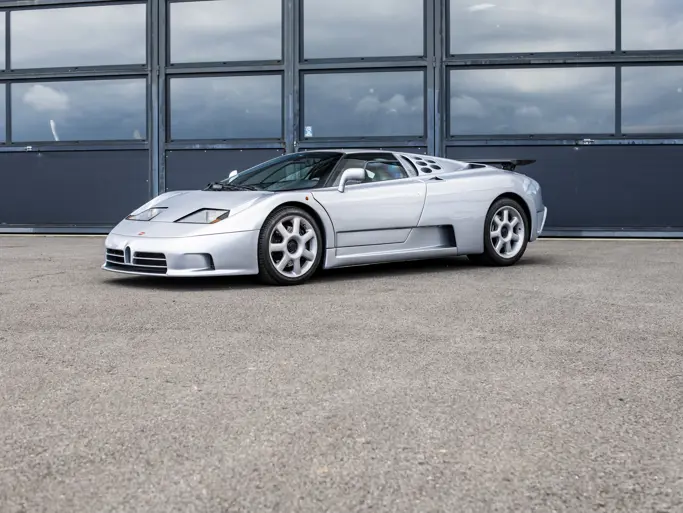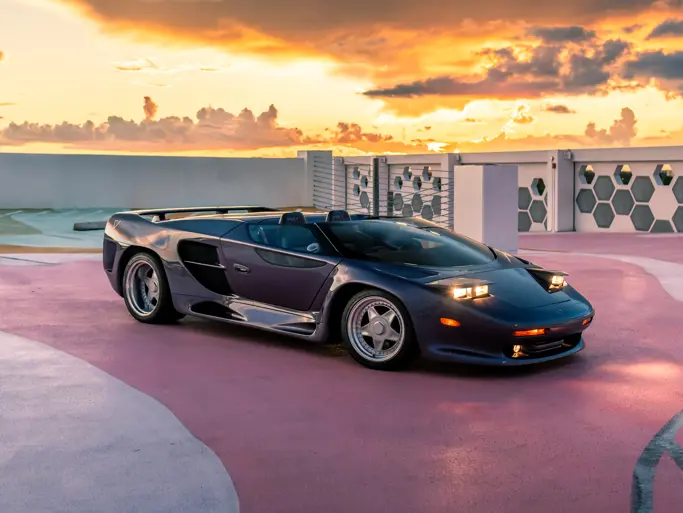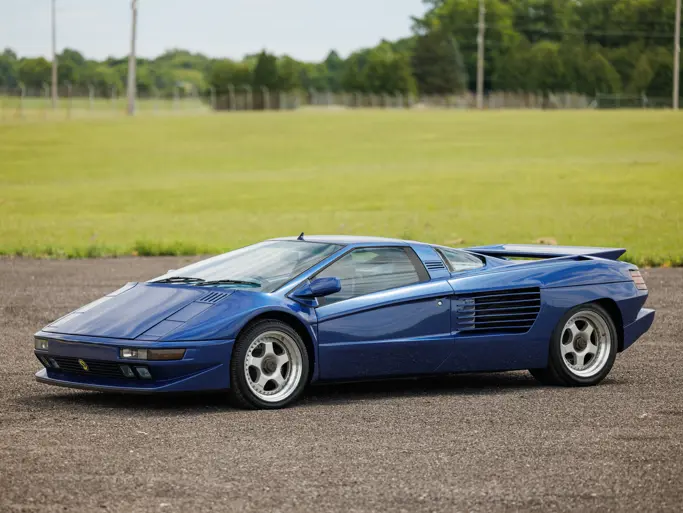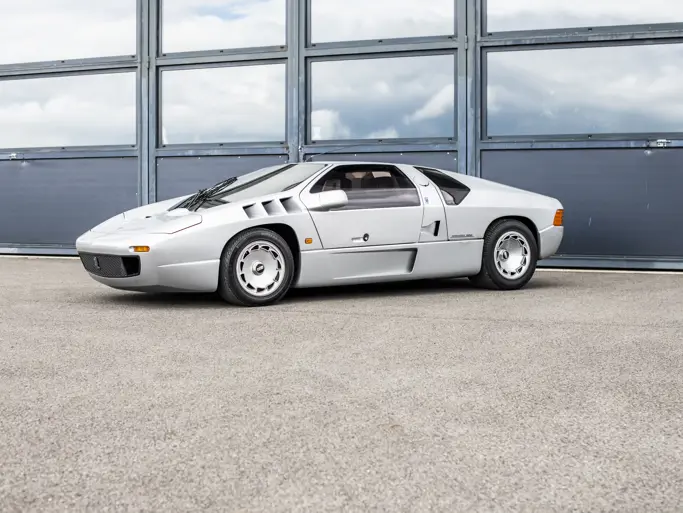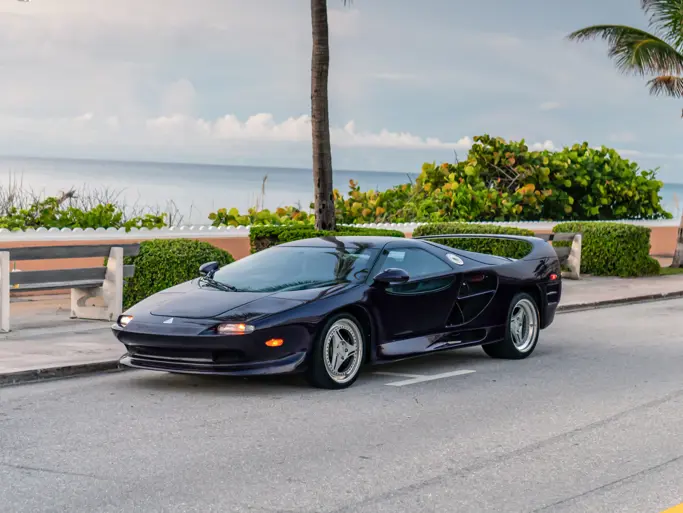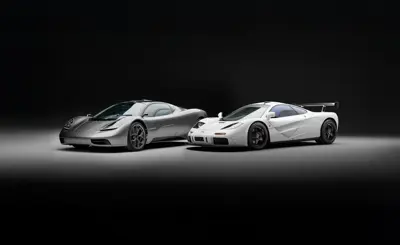Mention landmark supercars of the nineties and most people will think about the old favorites: Ferrari F50s, Lamborghini Diablos, and Porsche 911 Turbos. And while those poster pin-ups understandably stole the headlines, away from the limelight the decade was also known for a raft of boutique supercars that challenged the existing hegemony—incredible high-performance, limited-production models that were the product of visionaries and dreamers. This year’s Monterey auction, which takes place on 15-17 August, provides a fascinating insight into an amazing period of supercar production, with no fewer than eight outstanding examples of boutique supercars you may never have heard of, from the Marcello Gandini-designed 1993 Cizeta V16T to the wild all-American 1993 Vector Avtech WX-3 Prototype.
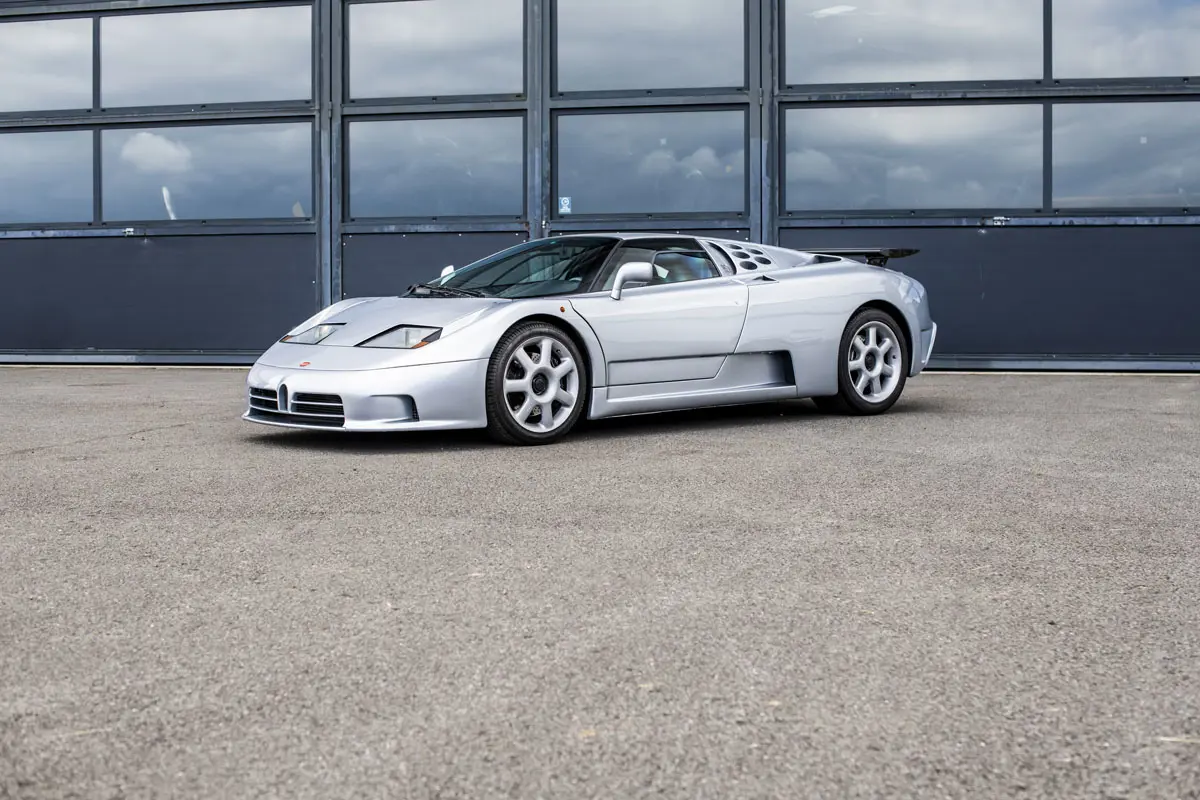
1993 Bugatti EB110 SS Prototype
Today, Bugatti has become one of the most successful hypercar manufacturers of the modern era. Rewind to the 1980s, however, and the famous name was nothing more than a sepia-tinted memory of past competition glories. One man saw a different future for the marque. Italian businessman Romano Artioli acquired rights to the famous brand in 1987 and immediately set about its resurrection, quickly breaking ground on a state-of-the-art production facility in Campogalliano, Italy.

The result, after about four years of painstaking development, was the EB110 GT, named in honor of Ettore Bugatti’s 110th anniversary. Initially designed by Marcello Gandini—famous for his work on the Lamborghini Miura, Countach, and Diablo—the project was seen through to completion by Technical Director Nicola Materazzi. It became one of only a handful of production cars of its era to break the 200-mph barrier.
Just six months after the EB110’s launch, work started on an even more developed variant—the Super Sport—boasting 603 horsepower, a crash diet fuelled by carbon fibre and a 0–60 mph time of just 3.2 seconds, with an incredible top speed of 216 mph. Just 30 production examples would be built, including a mere seven prototypes. This car is arguably the most significant, being the first of those prototypes specifically built as a Super Sport. In May 1993, the car participated in high-speed testing at the Nardo Ring, where the model achieved 351 km/h to become the world’s fastest production car.

1993 Vector Avtech WX-3 Prototype
The United States may have been the world’s automotive giant in the late 20th Century, but for all its power, the country lagged behind Europe when it came to marrying cutting-edge technology with absolute performance. Jerry Wiegert sought to redress that balance when he founded Vector Aeromotive in a small warehouse in Venice, Los Angeles in the 1970s, and set about creating America’s first supercar.
Powered by a twin-turbocharged General Motors 350-cubic-inch V-8 mated to a three-speed automatic gearbox, his W2 prototype was unveiled as a functioning model in 1979. The W8 that followed laid down a marker for the European elite, beating the likes of the Ferrari Testarossa, Lamborghini Countach, and Jaguar XJ220 over the quarter mile, and laying the groundwork for its most rounded creation ever: the Vector Avtech WX-3.

Wiegert’s groundbreaking new model was constructed using carbon fibre and Kevlar, with an interior that boasted a three-seat bench arrangement, lightweight sliding windows, and billet machined switchgear—and while it was dripping in aerospace technology, it was initially presented in non-running form. That changed in 1993, when the very same prototype—the exact car offered today—was relaunched with a 7-litre twin-turbocharged V-8 engine producing a claimed 1,000 horsepower. According to its creator, the car was good for 248 mph.
Sadly, the WX-3 never got beyond the prototype stage. In the face of a hostile takeover from Indonesian firm, MegaTech, and the legal wrangling that followed, plans for production were permanently shelved. This remains the sole product of one of America’s most promising supercar projects and was retained by Jerry Weigert until 2019. It has since been restored and has covered just 2,625 miles from new.
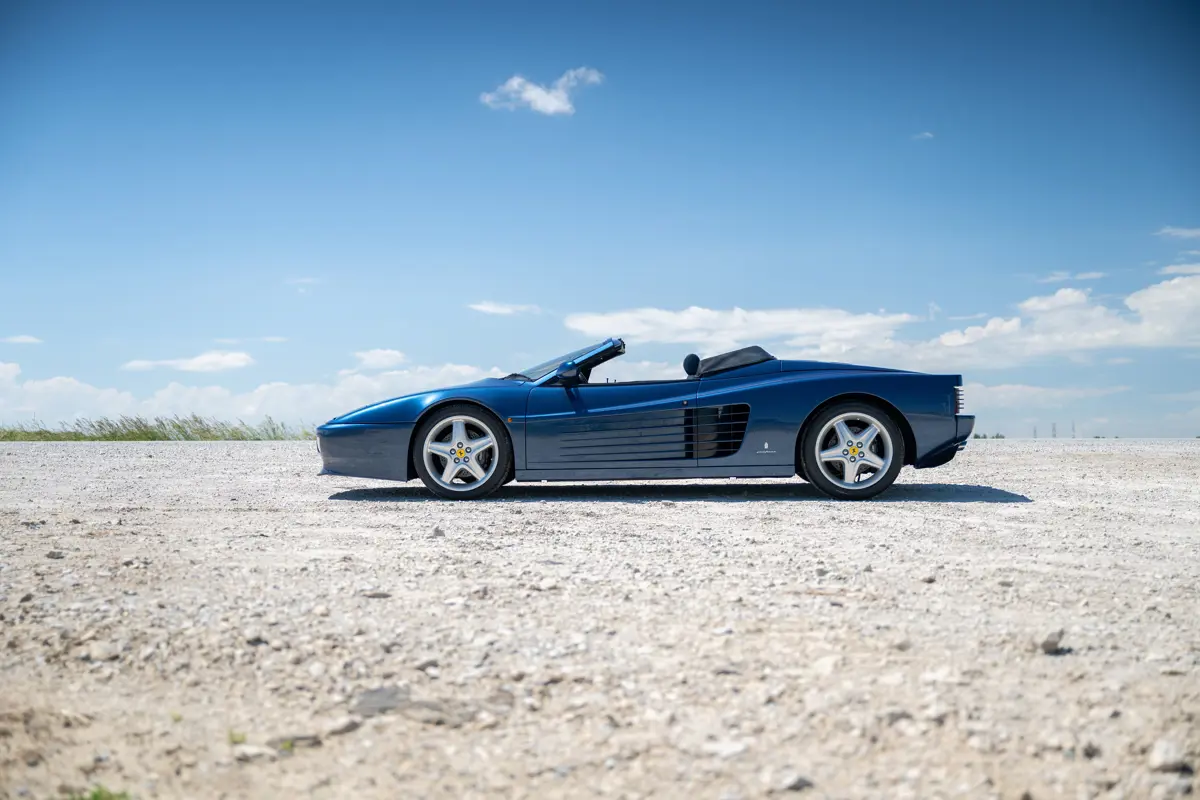
1993 Ferrari 512 TR Spyder by Pininfarina
By the 1990s, Ferrari had ramped up production of its flagship supercars. Compared with the limited production runs of the 1960s, the new breed was nothing short of mass-produced: even the exclusive Ferrari F40 numbered more than 1,300. It was the same story with the 512 TR, the latest and most modern iteration of the famed Testarossa, which racked up more than 2,200 examples by the time it was replaced by the F512 M. But despite the 512 TR’s popularity—or perhaps because of it—a handful of special examples were given the boutique treatment for special clients.

One of those clients was the Brunei Royal Family, customers of such standing that they were permitted to order cars too wild or specialized for series production. Countless fascinating special projects emerged from Maranello and the carrozzerie of the Motor Valley, among them this remarkable 512 TR Spyder—one of only two created by Pininfarina for Ferrari’s premier client and the only finished in the triple blue combination of Blu Cobalto over Blu Scuro Connolly leather.
The car was ordered for the Brunei Royal Family by Alfred Tan, owner of Singapore Ferrari distributor, Hong Seh Motors, but neither example ever made it to Sultanate. Instead, this car remained with Tan and served as the centerpiece of his own collection, making a rare appearance in Italy in January 1997 where it took part in Ferrari’s 50th Anniversary celebrations in Rome, before being acquired by the consignor in November 2023. It has since been subject to a 500-hour cosmetic refresh by RM Auto Restorations. It remains one of the rarest and most special Ferraris produced in the 1990s.

1993 Vector Avtech WX-3R Roadster Prototype
When Vector made its return to the Geneva International Motor Show in 1993, it didn’t just bring its revamped Avtech WX-3. The now Aquamarine supercar was joined by an arguably even more outrageous version, the open-topped Avtech WX-3R Roadster—a vision of the future in Amethyst Purple.
Like its coupé counterpart, the fighter jet-inspired WX-3R Roadster was a hand-built masterpiece of design that borrowed heavily from the aerospace industry local to Vector Aeromotive’s southern California base. Compared to its closed stablemate, the WX-3R Roadster was even more sleek thanks to a steeply raked windscreen that extended into the side windows and a lower, more streamlined rear spoiler that enhanced the Roadster’s aerodynamic profile. Things were different inside, too, with the WX-3’s bench seat replaced with figure-hugging Recaro bucket seats.

Beneath the car’s futuristic bodywork lay an all-aluminum 6-litre Rodeck twin-turbocharged V-8 engine paired with a Turbo-Hydramatic 425 automatic transmission—a combination capable of pushing the WX-3R well beyond 200 mph, and thus making it one of the fastest roadsters in the world. It would also remain of the rarest: this car is the very same prototype that caused such a stir at Geneva in 1993, and as a result of Jerry Wiegert’s company being wrested from him in a hostile takeover, no further examples were ever built. Instead, Wiegert moved on, seemingly content to keep his two creations for personal use.
Since leaving its creator’s care in 2019, this remarkable prototype has been subject to $116,000 of mechanical and aesthetic improvements by Miller Motorcars of Greenwich Connecticut, and would make a show-stopping addition to any top collection.

1993 Cizeta V16T
Los Angeles became something of a hotbed of boutique supercar production in the 1990s—and it wasn’t just Vector Aeromotive that put the city on the map. In the 1980s, former Lamborghini test driver and engineer, Claudio Zampolli, moved to the United States, and not long after he teamed up with music producer, Giorgio Moroder, with the dream of creating his own supercar rather than just servicing other people’s.

What followed was a supercar unlike any other. Breaking with convention, the Cizeta V16T was powered by a wild 6-litre transversely mounted V-16 engine allied to a five-speed manual gearbox, while the stunning coachwork was styled by none other than Marcello Gandini, the genius who had penned iconic wedge designs including the Lamborghini Countach and Lancia Stratos. Ultimately, just nine of these fabulously expensive machines were produced.
The Cizeta V16T’s huge price tag and impressive specification drew interest from the world’s most wealthy collectors, including the Brunei Royal Family, who commissioned this blue example alongside a brace finished in black, accounting for one-third of total production. Interestingly, this car never made it beyond Hong Seh Motors in Singapore, and because of that was spared the unfortunate fate of the other two cars: both were later modified with Ferrari flat-12s. This remarkable car remains one of the very few post-war production cars to boast 16 cylinders, and is among the rarest and most ambitious supercars ever created.

1991 Isdera Imperator 108i Series 2
Eberhard Schulz may have been a Porsche employee, but that didn’t stop him from working on his own projects. After punching out at Zuffenhausen the designer got straight to work each evening, moonlighting on two incredible hand-built concept cars that caught the attention of the motoring world. He eventually left Porsche and, after a short stint with tuner, Rainer Buchmann, during which he helped develop the CW311, set up his own company—Isdera—in 1982.

Schulz had only been out on his own for two years when he unveiled the Imperator 108i, a supercar heavily based on the CW311 that featured a tubular steel spaceframe chassis, a V-8 engine sourced from Mercedes-Benz, a bonded glass fibre body, and gullwing doors inspired by the original 300 SL. The Imperator was relatively long-lived for a boutique supercar, and though it ultimately remained in production for nine years, going through countless revisions, only 30 examples were ever built.
Given their rarity, most people couldn’t even name the Isdera Imperator if they saw one on the street. This example is actually a Series 2 car, which differs from the original in its pop-up headlamps and slightly softer styling. The front grille is also bigger, there’s an impressive NACA duct on the bonnet, and cooling vents behind the front wheel arches. Tastefully finished in silver over black leather, the car is powered by a 300-horsepower M119 Mercedes-Benz V-8—a relation of the engine that powered everything from the R129 SL to the CLK GTR.

1991 Vector W8 Twin Turbo
Today, Christian von Koenigsegg is the undeniable king of technology. But back in the 1980s and early 1990s, long before the Swede’s eponymous firm had been founded, it was Jerry Wiegert’s Vector Aeromotive that was at the forefront of modern vehicle design. The car that brought Vector to the world’s attention was the W8 Twin Turbo, an incredible fusion of aerospace technology, advanced components including carbon fibre and Kevlar, and a thunderous dry-sump 6-litre V-8 engine with forged internals that enabled the supercar to cover the quarter mile in just 12 seconds—faster than Ferrari’s halo-model Testarossa.

Like every Vector model that would come, the W8 Twin Turbo was a vanishingly rare machine. Just 17 were built before the firm closed its doors, meaning they were hardly ever seen outside the pages of specialist automotive magazines. Said to have been inspired by the Alfa Romeo Carabo concept car, the scissor-doored creation was angular and futuristic—and arguably more forward-thinking than any of its European competitors.
This car is one of those 17 production examples, and the only one to be finished in purple over black leather, and though it was ordered in 1989 it wasn’t delivered until two years later. Today, it stands as a fascinating piece of automotive history—but one that can be driven and enjoyed, having benefitted from a thorough refresh by none other than David Kostka, Vector’s former Chief of Engineering.

1996 Vector M12
The Vector Avtech WX-3 and its Roadster counterpart were sadly snuffed out before entering production when the company that produced them was forcibly taken over by Indonesian firm MegaTech in 1994. But in every cloud, there is a silver lining, and in this case, it came with 12 cylinders and a healthy dose of Italian style.
Following the takeover, Vector Aeromotive was moved from the west coast of the United States to Jacksonville, Florida, in order to combine resources with another of MegaTech’s recent acquisitions: Lamborghini. Jerry Wiegert had retained the intellectual rights to the outgoing WX-3, forcing Vector back to the drawing board for its next supercar project. However, engineers didn’t start from scratch. Instead, development was based heavily on one of the company’s existing supercars: the Lamborghini Diablo.

The Diablo donated both a modified version of its chassis and a mid-mounted version of its 7-litre V-12 engine to the new Vector M12, providing around 500 horsepower and enabling the car to hit 60 mph in just five seconds. The styling, meanwhile, was heavily influenced by the early WX-3, with a more refined interior thanks to a raid on the Lamborghini parts bin. Sadly, only 17 examples had been built by the time production drew to a close in 1999—not helped by MegaTech selling Lamborghini to Audi and its supply of engines drying up.
With just 14 proper production cars having been built, owning a Vector M12 is a fabulous opportunity to stand out from the crowd. This car, just the fifth of its type to be built, takes things even further, being the only example finished in this shade of purple. Among the rarest supercars ever built, this magnificent Vector has the power to stop traffic.


